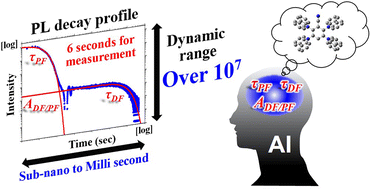High-throughput transient photoluminescence spectrometer for deep learning of thermally activated delayed fluorescence materials†
Abstract
Thermally activated delayed fluorescence (TADF) materials, promising light-emitters in organic light-emitting diodes, have been extensively studied for this decade. Despite this, theoretical prediction of their photophysical properties is still challenging owing to the complex structure–property relationship. Therefore, deep learning has recently been explored for the prediction of photophysical properties; however, obtaining a sufficient number of kinetic rate constants over a wide range restricts the robustness of the prediction. In this study, we propose a high-throughput and high-dynamic-range transient photoluminescence (PL) spectrometer for the rapid collection of PL decay profiles of TADF materials. In contrast with the conventional single-photon counting method, the proposed method reduces the measurement time of a PL profile from 3 h to 3 s and extends the acquirable range of the reverse intersystem crossing rate, a primary kinetic parameter of TADF, to a lower side of ∼103 s−1. Furthermore, we established that PL decay parameters obtained by the new apparatus can be used as new variables for deep learning. This study is expected to contribute to the prediction of photophysical properties and structural design of TADF materials using deep learning.



 Please wait while we load your content...
Please wait while we load your content...